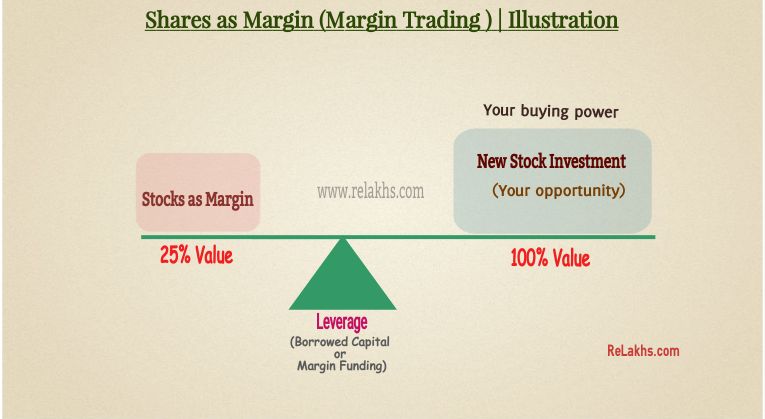SEBI has recently come up with tighter margin norms and new pledge system for the stock margin trading transactions. This has been the talk of the town among the stock market trading community.
In this post, let’s discuss – What is Margin Trading? What is the existing process of Margin trading or funding and proposed new Margin Trading process that SEBI has announced?
What is Stock Margin Trading?
Let’s imagine a situation where-in you have Rs 100 in your pocket but you are allowed to buy things that are worth Rs 500, that’s 5 times the funds you have.
This is what exactly referred to as ‘Margin Trading‘ or ‘Margin Trade Funding’ in stock trading parlance. The trading term ‘margin’ means that a stock broker is providing the client more purchasing power than he/she actually has in his/her account.
It sounds very beneficial to you, but, how does it benefit the stock broker? Remember one thing – there’s no such thing as a free lunch!
Example-1 : If you have Rs 100 with you and would like to buy a stock which is worth Rs 500 then you would be paying Rs 100 (margin money) and your stock broker provides LOAN of Rs 400. Of course, you need to pay brokerage and/or INTEREST on the borrowed funds (depending on the terms & conditions).
Example-2 : Suppose you have Rs 1,00,000 with you in your Bank account. You can use this amount to buy 10 shares of Infosys Ltd at Rs 10,000 per share. In the normal course, you will pay for the shares on the settlement day to the exchange and receive 10 shares from the exchange which will get credited to your demat account. Alternatively you could use this money as margin and suppose the applicable margin rate is 25%. You can now buy upto 40 shares of Infosys Ltd. at Rs 10,000 per share for value of Rs 4,00,000, the margin for which at 25% i.e. Rs 1,00,000.
Margin is the difference between total value of shares purchased and the loan amount provided by your broker.
Margin Trading through Stock Pledging
In the above mentioned example, you are paying Rs 100 in cash and the remaining amount is funded by your broker. Transferring cash is straight forward, no issue

There is another way of funding ie stock or security pledging. Under this scenario, brokers accept margin funding with Stocks/Securities (Shares as Margin) already held by you (investor) in your demat account as COLLATERAL.
For example : If you already own shares of Infosys worth Rs 1 lakh in your stock portfolio and you are predicting a price rise in another stock say Larsen & Toubro in next 7 days and you would like to covert this opportunity into gains.
You can deposit / pledge your shares (Infosys) as collateral with your stock broker and use that cash (which will be less than Rs 1 lakh, say Rs 75,000) to buy L&T shares.
Once you sell the L&T shares, you can pay back the broker the borrowed amount (Rs 75,000) along with the agreed interest and can ‘free’ your Infosys shares as collateral. This is often referred to as margin funding as a loan for Securities against securities.
This ‘Stock pledging’ has been the main ‘contentious‘ issue. SEBI has been receiving numerous complaints from the investors about the mis-use (pledge / sell) of their securitiesby some of the intermediaries or brokers.
I am sure you must have heard or read about the recent KARVY Stock broking mess..
Stock Margin Trading – The Existing Process
Let’s understand the existing Stock (margin) pledge system in a brief way.
Most of the demat account holders give Power of Attorney (PoA) to their brokers while opening the accounts. Giving PoA to your stock broker effectively enables you to avail margin benefit using your shares in Demat account.
The brokers have been using Power of Attorney (PoA) to transfer clients shares into a separate ‘margin account’ for allocating trading limits. Since the broker held the PoA, further client permission was not required to transfer shares for margin.
When an investor pledges his/her stock holdings to obtain margins, he/she has to transfer securities from his demat account to the broker’s account. The broker then pledges these securities to the Clearing Corporation. This transfer of title (ownership) of the securities leaves a gaping hole in the system, allowing some brokers to misuse these securities. (This form of title (ownership) transfer is now allowed till 31-Aug-2020 only.)
This problem has now been addressed by introducing the new pledge system by the SEBI. They have now discontinued the PoA process for margin.
Stock Margin Pledge Rules 2020 – Stocks as Margin & the new process
In the new proposed stock pledge system, the stock holdings don’t leave the your (investor’s) demat account, instead a pledge is just marked in favor of the broker.
Effective 1st August 2020, securities held in your demat account will NOT be considered towards margins and fresh transfer of securities from your demat account to Margin account of broker shall be prohibited unless Margin Pledge is created. It means you will have to individually place a request for pledging your shares to avail margin benefit.
Your broker is required to open a separate demat account labelled ‘TMCM – Client Securities Margin Pledge Account’ for this purpose (TMCM stands for Trading Member Clearing Member). The broker then re-pledges these securities in favour of the Clearing Corporation and obtains margins.
A client shall pledge securities with Trading Member (TM ie broker), and TM shall re-pledge the same with Clearing Member (CM), and CM in turn shall re-pledge the same to clearing corporation (CC). The complete trail of such re-pledge shall be reflected in the demat account of the pledgor.
As stocks in your portfolio do not leave your (investor’s) demat account, there is less chance of misuse of securities by your broker. ( Do note that if you fail to meet your margin requirement obligations, the broker will still have the right to invoke the pledge and sell them to revoke the dues, if any.)
This Process has very less implication to demat account holders who have NOT given Power of Attorney (POA) in favour of their stock brokers.
The SEBI has given couple of months time for all the intermediaries to implement this new process, until then, you may see both the processes running in parallel.
All new pledges will have to be created through the new pledge system effective August 01, 2020. Whereas, Brokers have been given time until the 31st of August to return all securities pledged using the existing framework and route them through the new pledge system.
Below is the indicative procedure for an investor to authorize the ‘pledging of shares’; (Your stock broker might have already shared similar information with you by email.)
- Visit to your Stock portfolio section in your Demat & Trading account.
- Select Shares you want to pledge from the list of shares you hold and then Click on “Pledge for Margin” option.
- A link for OTP authentication will be generated and sent on your registered Mobile Number and registered Email ID from Depository Participant (NSDL or CDSL). (If you have not yet updated your mobile number and email with your broker, its high time to update the same.)
- On clicking the link, you will be redirected to CDSL / NSDL webpage and prompted to enter your PAN or BOID (mandatory in case of PAN exempted clients). (BOID = Beneficial Owner Identification Number)
- Once the valid PAN / BOID is entered, list of all transactions pending for authentication will be displayed to you. Thereafter, OTP will be generated and sent on registered Mobile Number and registered Email ID of the client.
- You will have to then authenticate the same by entering the OTP whereupon the pledge shall be marked in favour of your stock broker.
- Once your request is received the margin benefit will be given to you on next Trading day (T+1).
- Brokers also provide ‘unpledge’ option (provided they aren’t blocked for margins), so that lien (collateral) on the stocks will be unmarked and the stocks become free securities in the demat.
This new stock pledge system is transparent and beneficial to the individual stock traders, but will come with some additional cost burden (this is in addition to the brokerage fees).
This creation and revocation of pledge attracts charges from the depository players (DPs) like Central Depository Services Ltd (CDSL) and National Services Depository Ltd (NSDL), and has to be borne by clients.
As per the current rates, the clients will have to bear a burden of Rs 50 per scrip up to a value of Rs 1 lakh shares pledged. Above this, the transaction per scrip will attract 0.5% cost of value of shares. So, its good news for NSDL / CDSL.
Besides the above new pledge system, the brokers have also been instructed to collect VaR (value at risk) and ELM (extreme loss margin) upfront from their clients. These rules will be implemented in a phased manner starting in December 2020 till August 2021.
Given that 80 to 90% of market turnover comes from the margin segment, we need to see how far these Margin Trading (NEW) Regulations 2020 going to impact the intra-day trading, margin trading and Futures & Option business turnovers in India.


